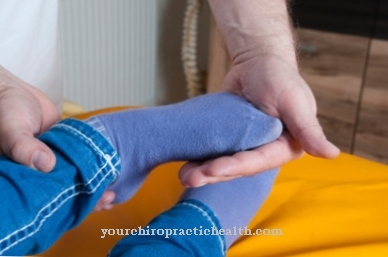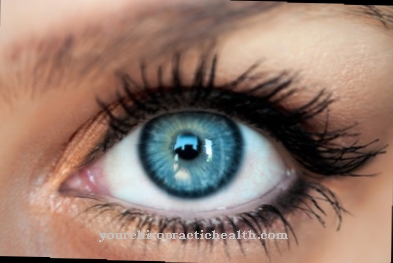As Surface sensitivity of the sense of touch, medicine summarizes the ability to epicritical and protopathic perception of pain, temperature and mechanical stimuli on the skin. The perceptions are relevant for both tactile and haptics. Sensitivity disorders are mostly due to nerve lesions.
What is surface sensitivity?

The sense of touch is also called the skin sense. It is one of five human perceptual instances. The skin sense is primarily used for exteroception, but in the case of the mucous membranes can also be used for interoception. The perception of stimuli from one's own body is just as much a part of the system's area of responsibility as that of stimuli from the environment.
The skin sense enables people to passively and actively perceive pressure, pain and temperatures. The active part is referred to as haptic and the passive part as tactile perception. The perceptual qualities of the sensory structure can differ according to different aspects, for example according to the type of stimulus, the place of excitation, the centripetal transmission and the interconnection in different core areas.
Based on the type of stimulus, medicine differentiates surface sensitivity into nociception for pain perception, thermal reception for temperature perception and mechanoreception for pressure, temperature, vibration and stretching.
The percepts of mechanoreception as well as the impressions of nociception and thermal reception are referred to as surface sensitivity. Surface sensitivity is interconnected in different core areas and includes both the protopathic coarse perception and the epicritical fine perception.
Function & task
The surface sensitivity is the most important quality of the skin sense. It is made possible by different receptors that are located as free nerve endings in the skin layers. These receptors are each specialized in binding to a specific stimulus molecule. In this context, mechanoreceptors are distinguished from thermo- and nociceptors. These sensory cells translate stimuli such as pressure, pain or temperature into the language of the central nervous system (CNS). The sensors convert the stimuli into an action potential and pass them on to the CNS via afferent pathways.
In humans, tactile perception depends primarily on the mechanoreceptors of the skin. The individual receptors in this group are, for example, the Merkel cells and the Ruffini, Vater-Pacini and Meissner bodies. Through these receptors, for example, it is possible for humans to feel sustained pressure loads and stretching.
The perceptions of the mechanoreceptors correspond to the epicritical perception. The information from epicritical mechanoreceptors in the area of surface sensitivity travels via class Aβ nerve fibers in the direction of the central nervous system. The individual fibers run without crossing in the fasciculi, i.e. the posterior cord tract of the spinal cord.
Protopathic sensations of temperature and pain through the thermoreceptors and pain receptors contribute to surface sensitivity. These percepts migrate to the central nervous system via afferent nerve fibers of class Aδ and C and are subject to the mediation by free nerve endings. Immediately after entering the posterior horn of the spinal cord, the fibers of the protopathic pathways cross to the contralateral side, where they ascend into the anterior and lateral spinothalamic tract.
In the brain, the percepts from the individual receptors are processed into an overall perception. This process corresponds to a sensory integration and gives the person an overall impression of the currently acting stimuli. The surface sensitivity has its own memory that helps the brain to filter, interpret, assess and classify percepts.
For both active haptics and passive tactile tactics, surface sensitivity with its pain, temperature and mechanical qualities is a crucial component.
Illnesses & ailments
Neurology distinguishes disorders of surface sensitivity into hyperesthesia, anesthesia, hypesthesia and paresthesia. Hyperesthesia corresponds to excessive surface sensitivity. Medicine also describes an increased tactile perception as tactile defense. The hypersensitivity, so to speak, provokes a defensive attitude in the patient. Those affected avoid tactile stimuli such as touch. They often withdraw not only from contact with other people, but also from contact with certain materials such as sand, dust, mud, paste or felt and surfaces such as metal or wood. The reason for this is usually the perception of pain on the skin, which is caused by the excessive sensitivity.
The opposite of hyperesthesia are hypesthesia.These are reduced sensitivities, which usually correspond to a dull feeling on the skin. In the case of so-called anesthesia, the patient's surface sensitivity is completely absent and the affected areas of the skin are completely numb.
This phenomenon must be distinguished from abnormal sensations known as paresthesias. Unusual sensations can be expressed, for example, in a tingling sensation or a burning sensation. A cold stimulus on the skin is sometimes mistaken by patients for a scalding hot stimulus.
All of the above-mentioned disorders of surface sensitivity are primarily associated with nerve damage. Especially when the conduction pathways in the central nervous system are affected, the brain only receives insufficient information from the area of surface sensitivity. This type of nerve damage is a central nervous lesion that can sometimes be traumatic.
Tumors or neurological diseases such as multiple sclerosis are also possible causes. A disturbance of the surface sensitivity can just as well be due to the processing centers in the brain. Such damage can be caused by stroke or ischemia. Inflammation-related brain lesions are also possible.
Under certain circumstances, a disturbance of the surface sensitivity can also be traced back to a lack of sensory integration. Sensory integration disorders often go back to a genetic disposition and can be alleviated with certain training methods.



























